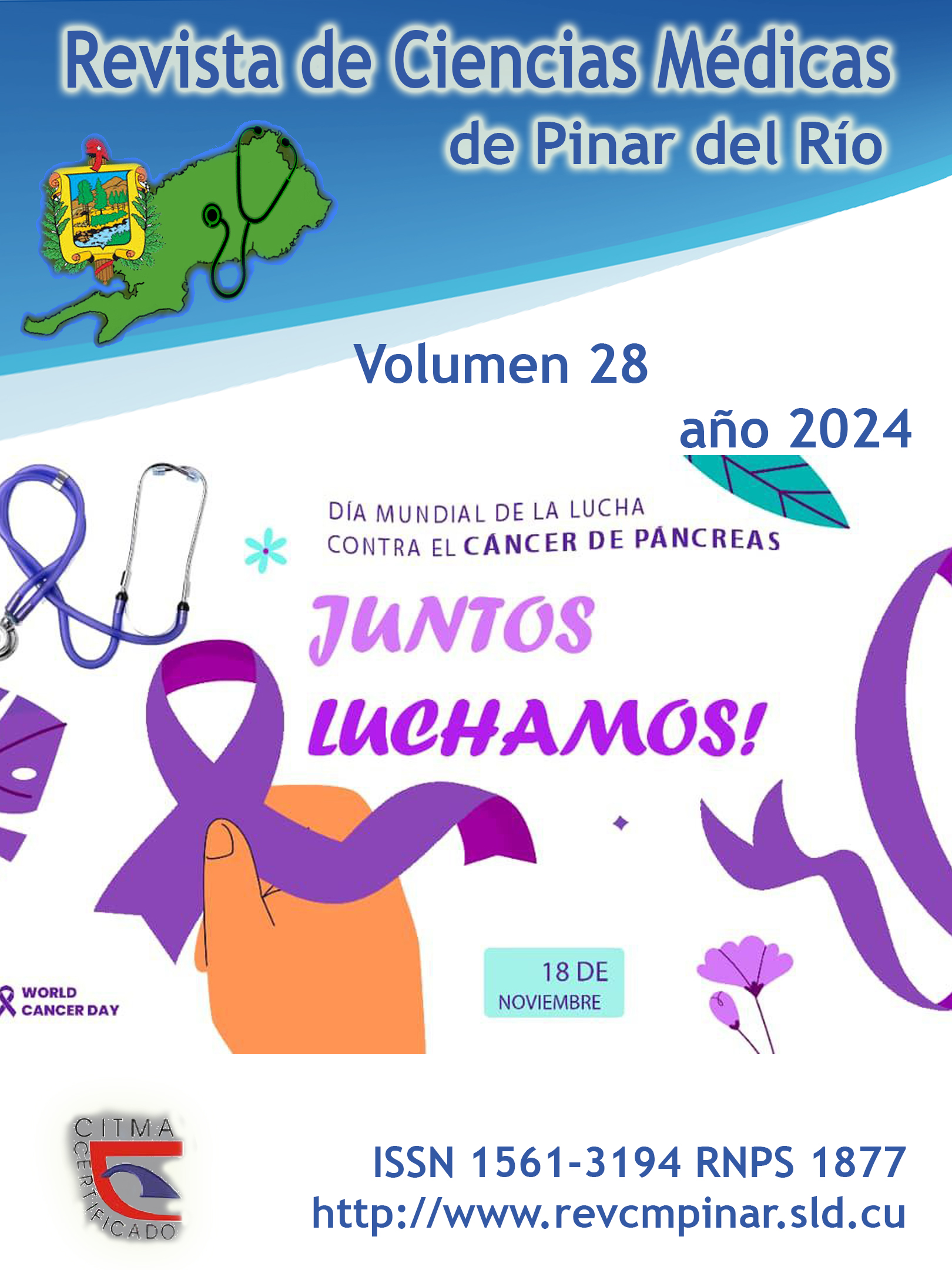Caracterización clínica epidemiológica del cáncer de ovario en el hospital Ginecobstétrico “Fe del Valle Ramos”
Palabras clave:
TUMOR DE OVARIO, TIPO HISTOLÓGICO, FACTORES DE RIESGO.Resumen
Introducción: el cáncer de ovario se produce como consecuencia de una acumulación de alteraciones genéticas que causa un crecimiento y proliferación incontrolada de las células epiteliales.
Objetivo: describir las características clínicas y epidemiológicas del cáncer de ovario en pacientes del Hospital Ginecobstétrico “Fe del Valle Ramos” en el periodo 2018-2022.
Métodos: se realizó un estudio descriptivo prospectivo con objetivo de determinar las características clínicas y epidemiológicas del cáncer de ovario en pacientes del Hospital Ginecobstétrico “Fe del Valle Ramos” en el periodo 2018-2022. Se trabajó con el 100 % del universo (60 pacientes); por lo que no se emplearon criterios de muestra. Los resultados se presentan en tablas, se emplearon métodos teóricos, empíricos y estadístico-matemático (cálculo porcentual).
Resultados: predominaron pacientes mayores de 45 años (73,3 %) y del municipio Manzanillo (50 %). La principal comorbilidad fue la obesidad (51,6 %). El factor de riesgo que más prevaleció fue el antecedente de cáncer de ovario para un 68,3 %. El tipo histológico más predominante fue el epitelial (86,6 %), subtipo: seroso (35 %). La mayoría de las pacientes estaban etapas clínicas III (36,6 %) del tumor de ovario. Se empleó como tratamiento prevaleciente la cirugía (86,6 %).
Conclusiones: la neoplasia de ovario predomina en pacientes mayores de 45 años, se encuentra relacionado con comorbilidades como la obesidad, presenta alta incidencia en pacientes con antecedentes de cáncer de ovario, es predominante el tipo histológico epitelial. Es una neoplasia que generalmente se diagnostica en estadios avanzados (III y IV), lo que le confiere peor pronóstico. La cirugía es la base fundamental del tratamiento.
Descargas
Citas
1. Organización Mundial de la Salud. Cáncer [Internet]. OMS; 2018 [citado 16/08/2021]. Disponible en: https://www.who.int/es/news-room/fact-sheets/detail/cancer
2. International Agency for Research on Cancer. GLOBOCAN 2018: Estimated Cancer Incidence, Mortality and Prevalence Worldwide in 2018 [Internet]. Lyon: OMS; 2018 [citado 16/08/2021]. Disponible en: https://gco.iarc.fr/AmericanCancerSociety
3. Instituto Nacional del Cáncer (enero 2018). Tratamiento del cáncer de ovario. [Internet]. 2018 [citado 16/08/2021]. Disponible en: https://www.cancer.gov/espanol/tipos/ovario/paciente/tratamiento-epitelial ovario-pdq
4. Sequeira Robles GC. Epidemiología del cáncer de ovario en pacientes intervenidas por servicios no oncológicos referidas a oncología del Hospital Bertha Calderón Roque en el periodo de enero del 2015 a diciembre del año 2017 [Tesis]. Managua: Universidad Nacional Autónoma de Nicaragua; 2018 [citado 16/08/2021]; Disponible en: https://repositorio.unan.edu.ni/9051/
5. Jean Guerra C, Franco Calderaro DG. Importancia de las características sociodemográficas y epidemiológicas en el manejo de los tumores de ovario. Rev Digit Post [Internet]. 2020 [citado 16/08/2021]; 9(3). Disponible en: https://portal.amelica.org/ameli/jatsRepo/101/1011187012/101118
6. Cortés Morera A, Ibáñez Morera M, Hernández Lara A, García Carranza MA. Cáncer de Ovario: Tamizaje y diagnóstico imagenológico. Medicina. pierna. Costa Rica [Internet]. marzo de 2020 [citado 06/02/2023]; 37(1): 54-61. Disponible en: https://www.scielo.sa.cr/pdf/mlcr/v37n1/2215-5287-mlcr-37-01-54.pdf
7. Menon U, Karpinskyj CH, Gentry MA. Prevención y detección del cáncer ovárico. Obstet Gynecol [revista en Internet]. 2018 [citado 19/05/2022]; 131(2): 909-27. Disponible en: https://journals.lww.com/greenjournal/Documents/May2018_Translation_Menon.pdf
8. González Fernández H, Morales Yera R, Santana Rodríguez S, Reinoso Padrón L, Heredia Martínez B. Caracterización clínico-epidemiológica del cáncer de ovario. Revista Finlay [Internet]. 2021 [citado 06/02/2023]; 11(4): 359-370. Disponible en: http://revfinlay.sld.cu/index.php/finlay/article/view/1071
9. Pérez Cutiño M, Alonso Remedios A, González Ortega E. Expresión del receptor de factor de crecimiento epidérmico en cáncer de ovario. Rev Cubana Obstet Ginecol [Internet]. 2018 Jun [citado 06/02/2023]; 44(2): 1-11. Disponible en: http://scielo.sld.cu/scielo.php?script=sci_arttext&pid=S0138-600X2018000200018&lng=http://scielo.sld.cu/scielo.php?script=sci_arttext&pid=S0138-600X2018000200018&lng=es
10. Sociedad Española de Oncología Médica SEOM. Factores asociados a cáncer de ovario [Internet]. 2020 [citado 24/03/2022]. Disponible en: https://seom.org/info-sobre-el-cancer/ovario?showall=1
11. Sánchez Vega JF, Vintimilla Condoy AS. Marcador CA-125, en tumores epiteliales malignos de ovario y factores asociados, en pacientes del Instituto del Cáncer Solca, Cuenca 1996–2016. [Tesis]. Universidad de Cuenca. Cuenca-Ecuador; 2017. [citado 24/03/2022]. Disponible en: http://dspace.ucuenca.edu.ec/handle/123456789/27268
12. Rocha Monjará B, Zermeño Nava J. Sácido siálico y otros factores asociados en el diagnóstico de cáncer de ovario en pacientes con masas anexiales. [Tesis]. Universidad Autónoma de San Luis Potosí; 2020. Disponible en: https://repositorioinstitucional.uaslp.mx/xmlui/handle/i/5928
13. González Mariño MA. Carcinoma seroso de virio. Serie de 14 casos y revisión bibliográfica. Gineco. Obste. Mex. [Internet]. 2021 [citado 24/03/2022]; 88(7). Disponible en: https://www.scielo.org.mx/scielo.php?pid=S0300-90412020000700004&script=sci_arttext_plus&tlng=es
14. Vásquez Cuela RS, Acosta Evangelista ZL. Factores de riesgo asociados a la prevalencia del cáncer de ovario en el HNDM del 2013 al 2017 [Tesis]. Universidad Nacional Mayor de San Marcos. Lima-Perú; 2019 [citado 24/03/2022]. Disponible en: https://cybertesis.unmsm.edu.pe/bitstream/handle/20.500.12672/10338/Vasquez_cr.pdf?sequence=3&isAllowed=y
15. Zambrano B, Santos M, Díaz L, Omaña D. Experiencia en el tratamiento del cáncer ovárico avanzado. Rev Venez Oncol [Internet]. 2017 [citado 24/03/2022]; 29(4). Disponible en: https://www.redalyc.org/jatsRepo/3756/375652706004/html/index.html
16. García Alonso I, Linchenat Lambert A, Pérez Martínez R, Silveira Pablos M, Esperón Noa R, Aguilar Vela de Oro K. Estudio longitudinal: Cáncer de Ovario en el Instituto Nacional de Oncología y Radiobiología de Cuba (INOR), resultados del tratamiento. Rev. Oncol. Ecu [Internet]. 2018 [citado 24/03/2022]; 28(2): 150-162. Disponible en: https://doi.org/10.33821/106
Publicado
Cómo citar
Número
Sección
Licencia
Aquellos autores/as que tengan publicaciones con esta revista, aceptan los términos siguientes:- Los autores/as conservarán sus derechos de autor y garantizarán a la revista el derecho de primera publicación de su obra, el cuál estará simultáneamente sujeto a la Licencia de reconocimiento de Creative Commons que permite a terceros compartir la obra siempre que se indique su autor y su primera publicación esta revista.
- Los autores/as podrán adoptar otros acuerdos de licencia no exclusiva de distribución de la versión de la obra publicada (p. ej.: depositarla en un archivo telemático institucional o publicarla en un volumen monográfico) siempre que se indique la publicación inicial en esta revista.
- Se permite y recomienda a los autores/as difundir su obra a través de Internet (p. ej.: en archivos telemáticos institucionales o en su página web) antes y durante el proceso de envío, lo cual puede producir intercambios interesantes y aumentar las citas de la obra publicada. (Véase El efecto del acceso abierto).



